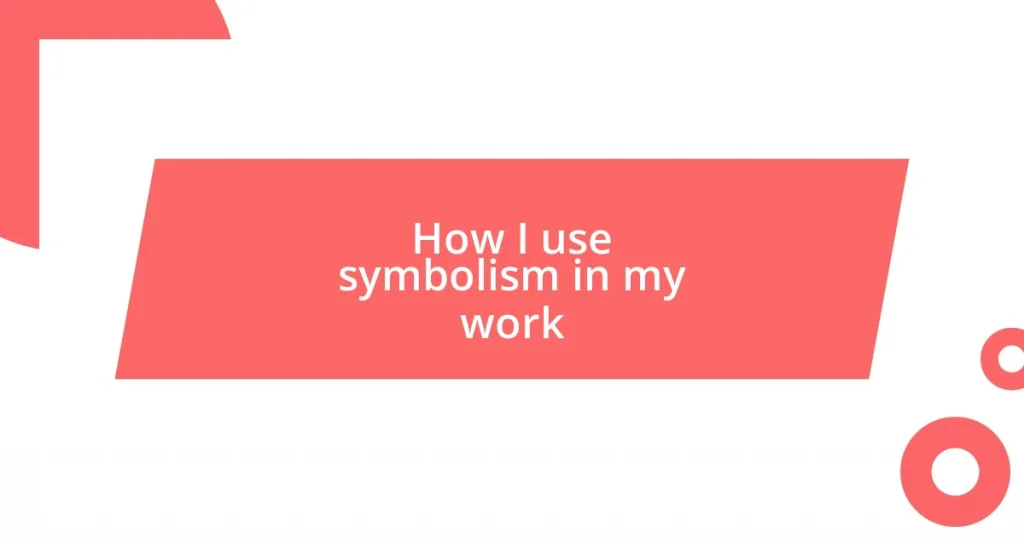Key takeaways:
- Symbolism in art enhances emotional connections between the artist and the viewer, transforming simple visuals into deeper narratives.
- Personal symbols often stem from introspection and everyday experiences, allowing artists to convey meaningful stories through familiar motifs.
- Audience interpretations of symbols reveal varied emotional responses, enriching the artistic narrative and prompting deeper discussions about personal and collective journeys.
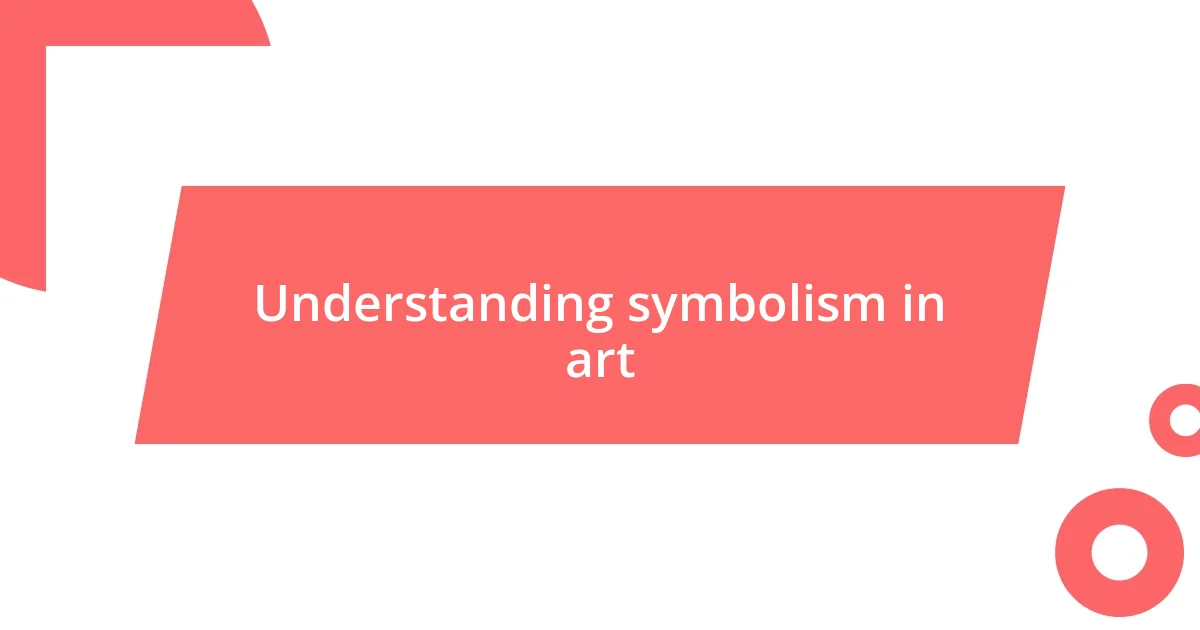
Understanding symbolism in art
Symbolism in art serves as a bridge, connecting the artist’s inner world with the viewer’s perception. I remember the first time I stood before a painting rich with symbols—a vibrant red rose that represented passion intertwined with shadows reflecting sorrow. It struck me how much deeper the meaning went beyond the surface, sparking questions like, “What story is the artist trying to tell?”
When I create, I often think about the weight of color and form. For example, I once used a broken clock in a piece to symbolize the fragility of time and memory. As viewers engaged with that work, some shared how it resonated with their own experiences of loss and the struggle against the relentless march of time. This exchange of emotions via symbolism creates a profound connection between the art and its audience.
Art transcends mere aesthetics; it invites dialogue. Have you ever looked at a piece of art and felt an inexplicable tug at your heart? That’s symbolism at play, making complex ideas accessible through visual language. For me, it’s about translating my thoughts and feelings into a visual narrative that invites viewers to pause, reflect, and perhaps see a part of their own journey reflected back at them.
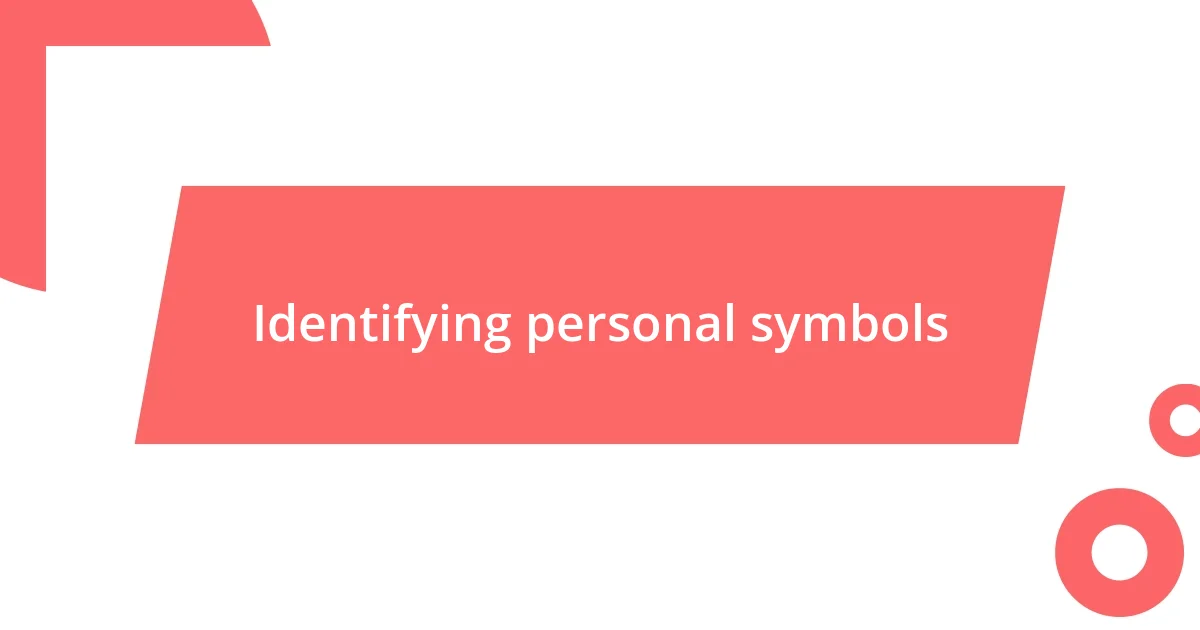
Identifying personal symbols
Identifying personal symbols often starts with introspection. I recall a moment when I was surrounded by nature after a particularly tough week. The towering pine trees and their deep green needles spoke to me, representing resilience and stability—qualities I aspired to embody. This connection urged me to incorporate those elements into my art, reminding me that my experiences could shape the symbols I use.
While exploring personal symbols, I also look to everyday life. During a quiet evening with friends, I noticed how our laughter echoed in the dim light, stirring a desire to capture that fleeting joy. I decided to use soft, glowing lanterns in my work. They symbolize warmth and companionship, capturing those moments of connection that often go unnoticed yet mean so much. It’s fascinating how the seemingly mundane can emerge as symbols that resonate deeply with our experiences.
To pinpoint what holds significance for me, I frequently journal. By reflecting on my emotions, experiences, and surroundings, I can sketch out motifs that feel authentically mine. For instance, I’ve consistently drawn a phoenix rising from ashes, representing rebirth and transformation through challenges. Each of these symbols is a piece of my story, layered with meaning that guides my artistic vision.
| Symbol | Personal Meaning |
|---|---|
| Pine Trees | Resilience and stability |
| Lanterns | Warmth and companionship |
| Phoenix | Rebirth and transformation |
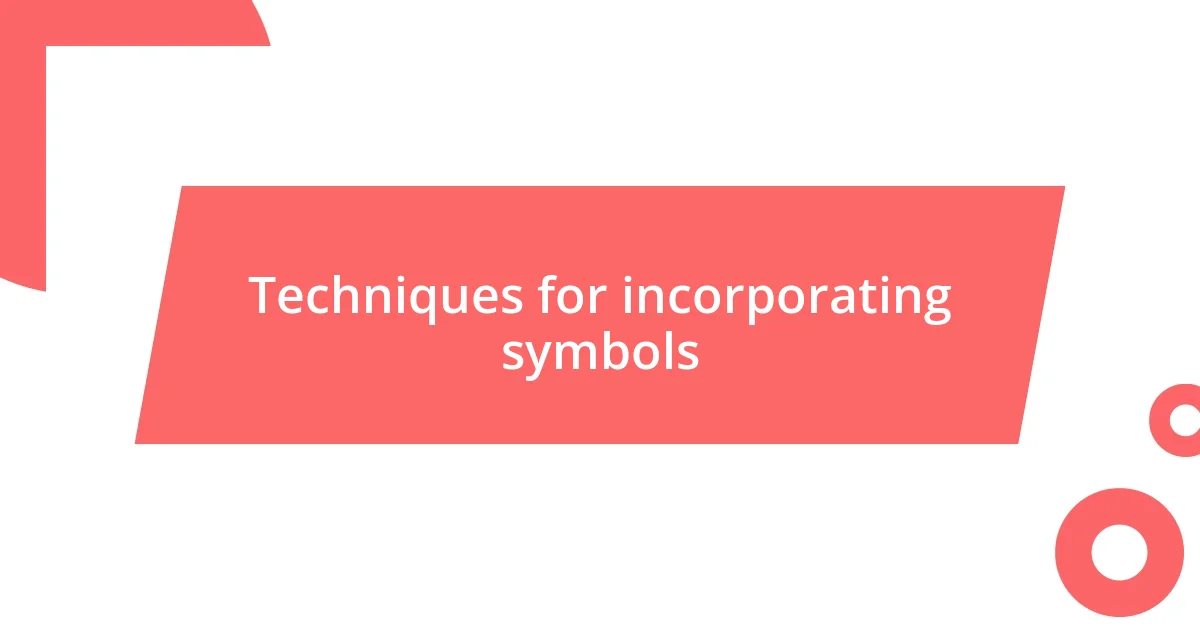
Techniques for incorporating symbols
Incorporating symbols in my work often involves layering meanings through various techniques that enhance the narrative. I remember one particular project where I played with texture alongside color. By adding a rough, jagged border around a soft watercolor scene, I illustrated the contrast between turmoil and peace. Each brushstroke told a story, revealing how chaos can coexist with serenity in our lives.
Here’s a quick list of techniques I find effective for using symbols:
- Contrast: Using opposing elements—like rough textures with gentle colors—to highlight deeper meanings.
- Repetition: Repeating a symbol throughout a piece reinforces its significance, creating a visual rhythm that captivates viewers.
- Juxtaposition: Placing two contrasting symbols side by side can prompt viewers to explore the relationship between them, sparking deeper reflections.
- Color Psychology: Choosing colors intentionally allows me to tap into the emotions they evoke; for example, blues often represent calmness, while reds can convey intensity.
Emotional insight plays a key role in my symbolic choices. When I included a solitary figure holding an umbrella against a downpour in one of my pieces, it was inspired by a moment of clarity during an emotional storm in my life. That was my way of showing resilience amidst adversity. The umbrella became a powerful symbol of hope and protection, prompting viewers to ponder their own sources of strength during difficult times.
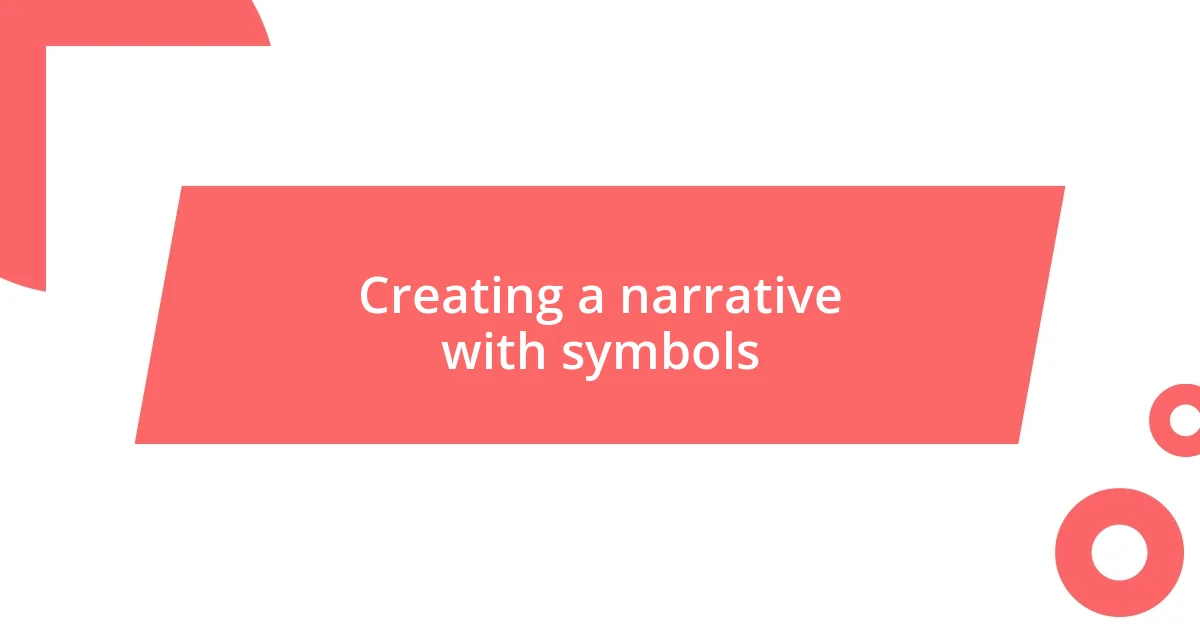
Creating a narrative with symbols
Creating a narrative with symbols transforms simple visuals into profound stories. I often find myself drawn to the moon, which has become a symbol in my work for fleeting moments of reflection. One night, while gazing up at a particularly bright moon, I felt a wave of nostalgia wash over me, leading to the idea of incorporating moonlit scenes to evoke those cherished memories of solitude.
In my artistic journey, I’ve come to realize that every symbol can tell a story. A piece I created featuring a winding path illuminated by fireflies reflects my personal journey through uncertainty. Those little lights represent guidance and hope amidst confusion. When viewers see it, I encourage them to ask, “What guiding lights do I have in my own journey?” This question not only invites them to engage with the artwork but also connects them to their own life experiences.
Every symbol I use serves a purpose, echoing emotions I want to convey. For me, a bridge often represents connection and transition. I recall creating a scene with a bridge hovering over turbulent waters, illustrating the delicate balance between leaving behind the past and moving into the future. This not only reflected my struggles but also sparked conversations with others about their own bridges. How do we navigate the waters of change in our lives? For me, this exploration through symbolism ensures that my narrative resonates on multiple levels.
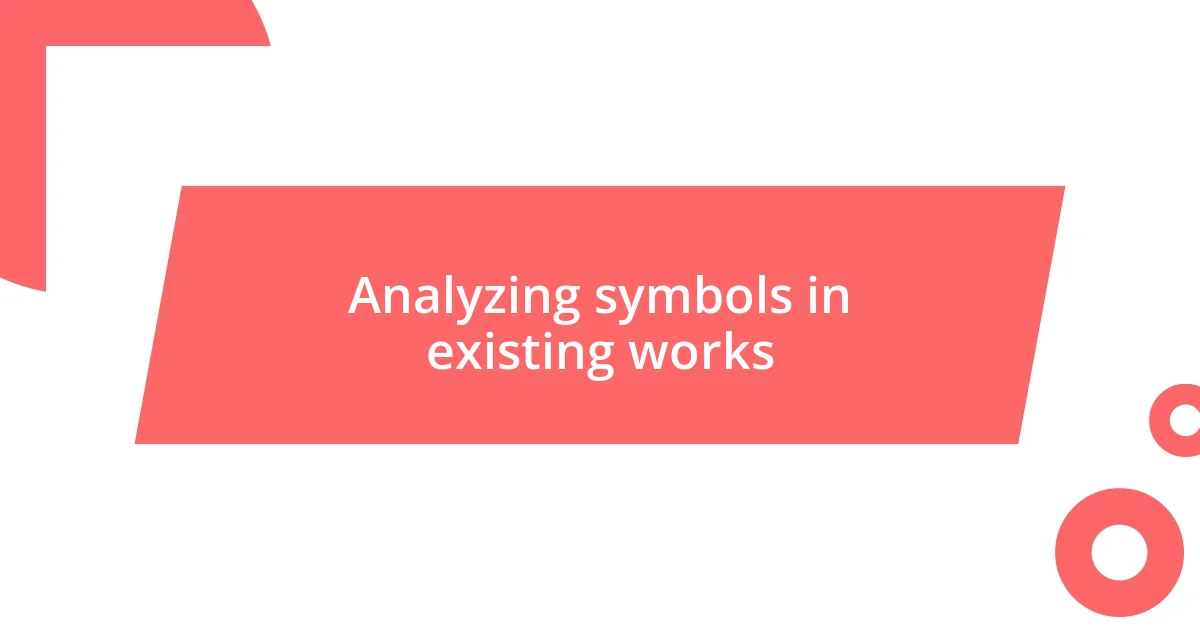
Analyzing symbols in existing works
Engaging with symbols in existing works can be a revealing experience. I recall analyzing a classic novel and discovering how the recurring imagery of a shattered mirror represented fractured identities. This deeper understanding changed my perspective on the protagonist’s journey, illuminating their struggles with self-acceptance. Have you ever noticed how such simple images can be so profound?
When I examined a painting that featured a wilting flower, I was struck by the contrasting vibrancy of the background. This juxtaposition highlighted themes of decay versus the beauty of life. It made me reflect on how fleeting moments can encapsulate deeper emotions. I’ll often ask myself, “What stories are these symbols eager to share with us?” This question brings a layer of intimacy to the art.
I find that exploring symbols in various works can evoke emotions and spark connections. In one piece, the use of an open door symbolized new beginnings and possibilities. It reminded me of my own experiences with significant life changes, where each door presented unique opportunities. By delving into these symbols, I realize we are often looking at reflections of our own journeys, making the analysis not just academic but deeply personal.
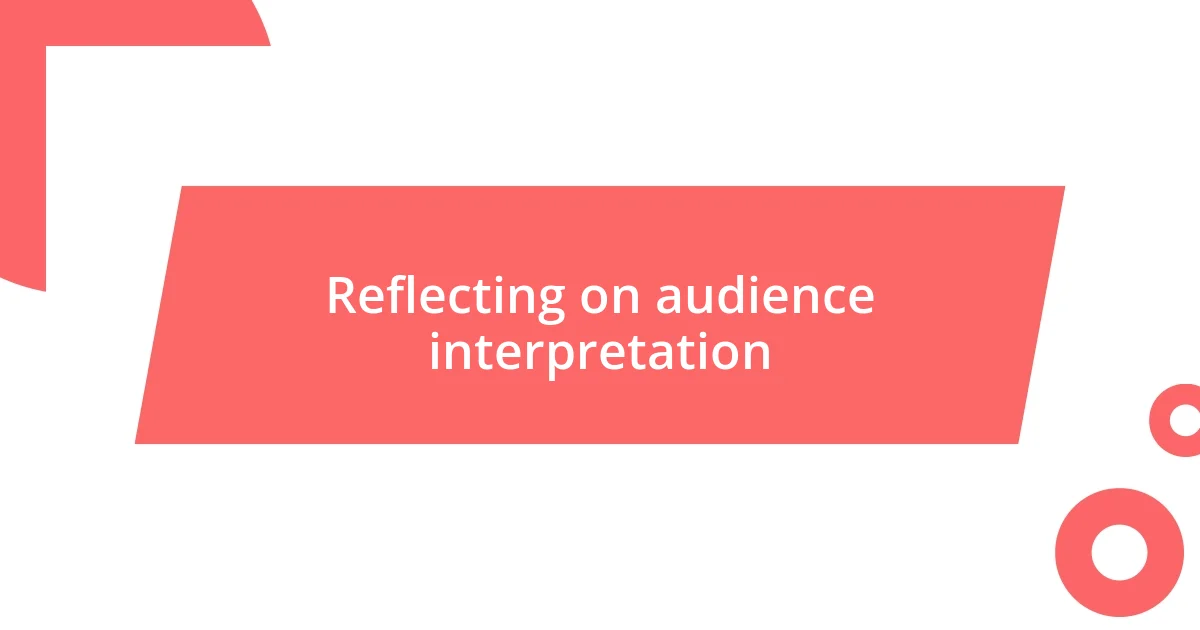
Reflecting on audience interpretation
Reflecting on how audiences interpret symbols in my work brings an enriching and sometimes surprising dimension to the creative process. I remember showcasing a piece featuring an abandoned house. Some viewers expressed feelings of nostalgia and loss, while others felt a sense of mystery and potential for new beginnings. It’s fascinating to see how a singular image can evoke such varied interpretations. Have you ever considered how your take on an artwork might differ from someone else’s? It’s a reminder that our personal experiences shape our understanding.
I once attended a gallery where a sculpture of intertwined vines sparked a discussion among attendees. Some viewed it as a representation of unity, while others saw it as a commentary on our entangled relationships. Listening to their conversations illuminated just how deeply symbolism can resonate. It made me realize that my intention behind the symbols can sometimes take a back seat to the audience’s emotional responses. Isn’t it incredible how art can become a mirror reflecting the audience’s thoughts and feelings?
Ultimately, I find that audience interpretation of symbols enriches the narrative I create. One piece I introduced used a winding staircase to symbolize growth and elevation, but some viewers related to it as a journey through struggles. Their insights transformed how I viewed my own work. Reflecting on these interpretations opens up conversations that deepen our collective understanding of art. What stories does your interpretation uncover, and how can we learn from one another’s perspectives?

Revising and refining symbol use
When revising symbols in my work, I often delve into their emotional resonance. I recall a piece where I used a key to represent freedom. Initially, it felt straightforward, but upon closer examination, I realized that the key also suggested a sense of vulnerability—what if the door opened to fear instead? This duality sparked my interest and led me to refine the symbol, making sure it captured the complexity of the human experience.
As I revisit my work, I like to ask myself, “What does this symbol convey to me, and what might it say to others?” For instance, I once incorporated a river to symbolize life’s journey. However, I noticed that some saw it as a source of chaos rather than a path of flow. This shift in perspective encouraged me to adjust the imagery, adding small boats to represent navigating through the tumult, enhancing the symbol’s richness and accessibility.
In the act of refining symbol use, I find that feedback plays a crucial role. I remember presenting a work where a compass was my focal point. The discussions surrounding its significance—direction versus indecision—made me reconsider its placement in the overall piece. It struck me how an audience’s insights can breathe new life into a symbol, shaping my approach as I move forward. What symbols in your work could transform with a little more reflection or dialogue with your audience?










